Uniform polyhedron on:
[Wikipedia]
[Google]
[Amazon]
In
 The 57 nonprismatic nonconvex forms, with exception of the great dirhombicosidodecahedron, are compiled by Wythoff constructions within Schwarz triangles.
The 57 nonprismatic nonconvex forms, with exception of the great dirhombicosidodecahedron, are compiled by Wythoff constructions within Schwarz triangles.

 The convex uniform polyhedra can be named by Wythoff construction operations on the regular form.
In more detail the convex uniform polyhedron are given below by their Wythoff construction within each symmetry group.
Within the Wythoff construction, there are repetitions created by lower symmetry forms. The cube is a regular polyhedron, and a square prism. The
The convex uniform polyhedra can be named by Wythoff construction operations on the regular form.
In more detail the convex uniform polyhedron are given below by their Wythoff construction within each symmetry group.
Within the Wythoff construction, there are repetitions created by lower symmetry forms. The cube is a regular polyhedron, and a square prism. The
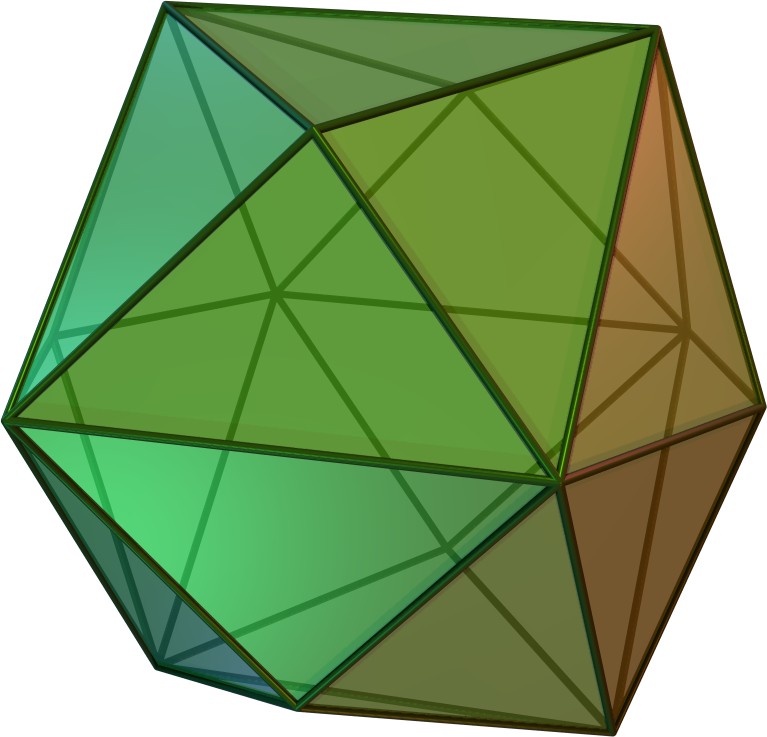


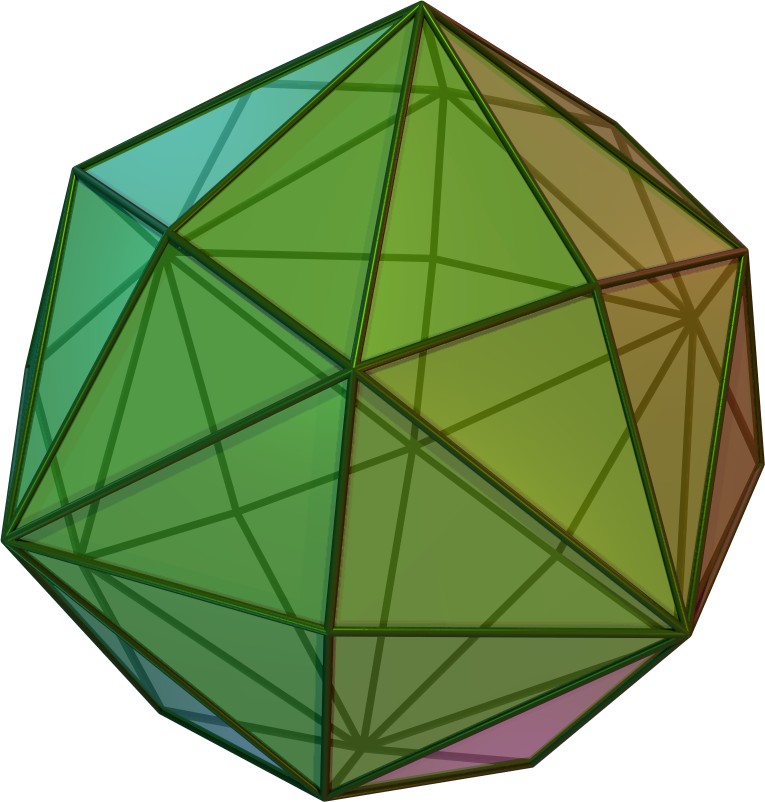


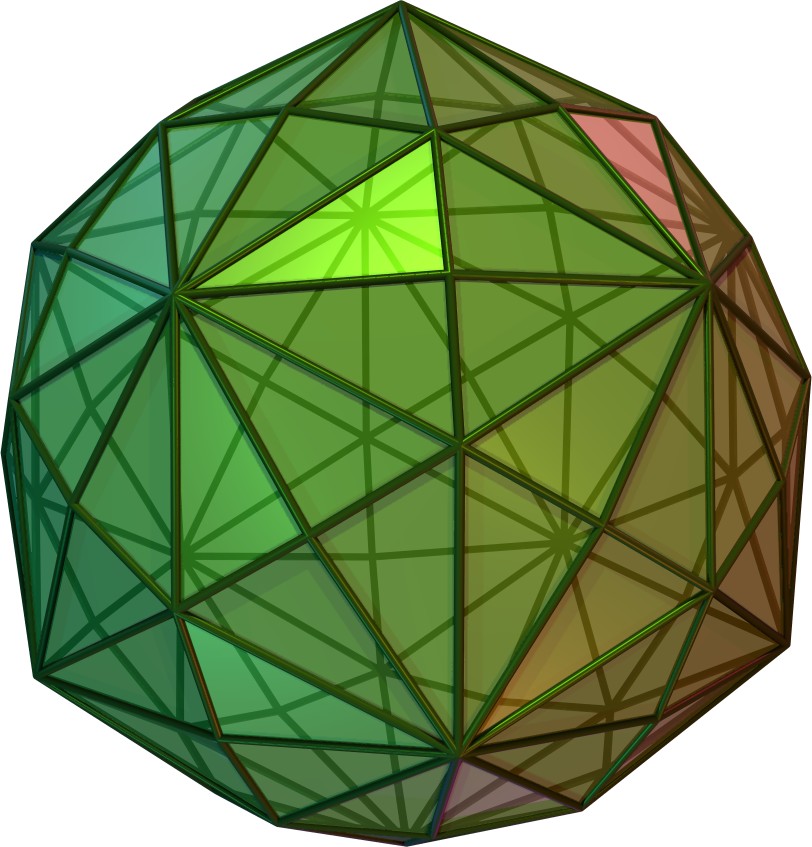
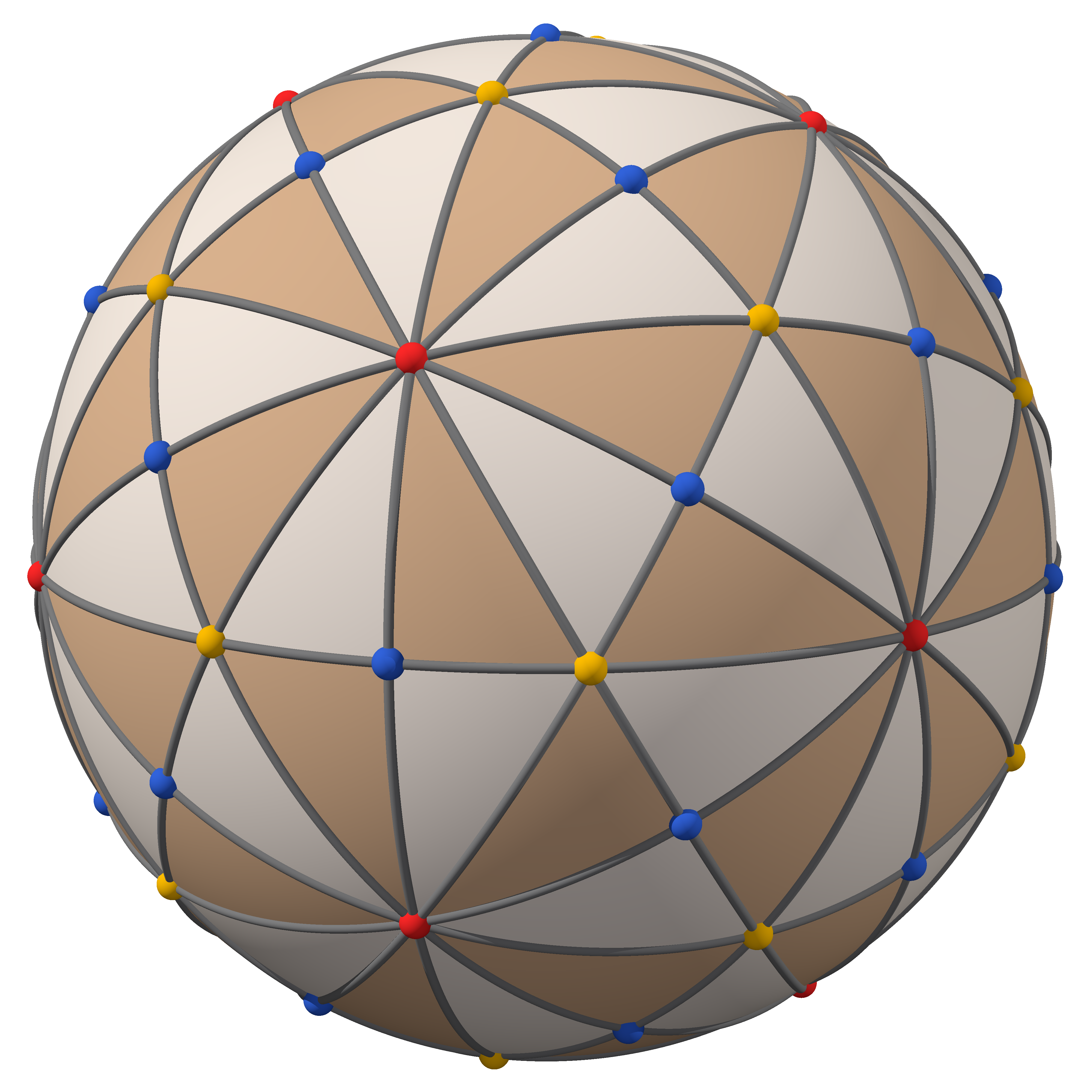






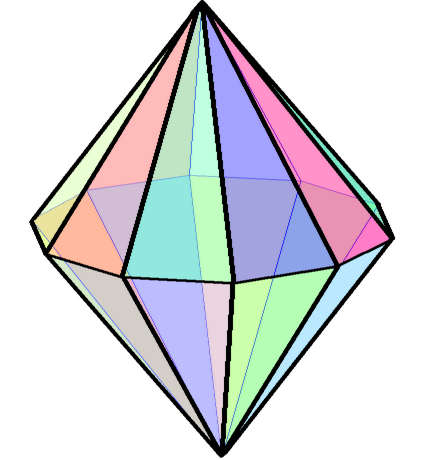
* * * * * * *
Uniform Solution for Uniform PolyhedraThe Uniform Polyhedra
Uniform Polyhedra
Uniform polyhedron gallery
''Has a visual chart of all 75'' {{Polytopes Uniform polyhedra, *
geometry
Geometry (; ) is a branch of mathematics concerned with properties of space such as the distance, shape, size, and relative position of figures. Geometry is, along with arithmetic, one of the oldest branches of mathematics. A mathematician w ...
, a uniform polyhedron has regular polygon
In Euclidean geometry, a regular polygon is a polygon that is Equiangular polygon, direct equiangular (all angles are equal in measure) and Equilateral polygon, equilateral (all sides have the same length). Regular polygons may be either ''convex ...
s as faces and is vertex-transitive—there is an isometry
In mathematics, an isometry (or congruence, or congruent transformation) is a distance-preserving transformation between metric spaces, usually assumed to be bijective. The word isometry is derived from the Ancient Greek: ἴσος ''isos'' me ...
mapping any vertex onto any other. It follows that all vertices are congruent. Uniform polyhedra
In geometry, a polyhedron (: polyhedra or polyhedrons; ) is a three-dimensional figure with flat polygonal faces, straight edges and sharp corners or vertices. The term "polyhedron" may refer either to a solid figure or to its boundary su ...
may be regular (if also face- and edge-transitive), quasi-regular (if also edge-transitive but not face-transitive), or semi-regular (if neither edge- nor face-transitive). The faces and vertices don't need to be convex
Convex or convexity may refer to:
Science and technology
* Convex lens, in optics
Mathematics
* Convex set, containing the whole line segment that joins points
** Convex polygon, a polygon which encloses a convex set of points
** Convex polytop ...
, so many of the uniform polyhedra are also star polyhedra.
There are two infinite classes of uniform polyhedra, together with 75 other polyhedra. They are 2 infinite classes of prisms and antiprism
In geometry, an antiprism or is a polyhedron composed of two Parallel (geometry), parallel Euclidean group, direct copies (not mirror images) of an polygon, connected by an alternating band of triangles. They are represented by the Conway po ...
s, the convex polyhedrons as in 5 Platonic solid
In geometry, a Platonic solid is a Convex polytope, convex, regular polyhedron in three-dimensional space, three-dimensional Euclidean space. Being a regular polyhedron means that the face (geometry), faces are congruence (geometry), congruent (id ...
s and 13 Archimedean solid
The Archimedean solids are a set of thirteen convex polyhedra whose faces are regular polygon and are vertex-transitive, although they aren't face-transitive. The solids were named after Archimedes, although he did not claim credit for them. They ...
s—2 quasiregular and 11 semiregular— the non-convex star polyhedra as in 4 Kepler–Poinsot polyhedra and 53 uniform star polyhedra—14 quasiregular and 39 semiregular. There are also many degenerate uniform polyhedra with pairs of edges that coincide, including one found by John Skilling called the great disnub dirhombidodecahedron, Skilling's figure.
Dual polyhedra to uniform polyhedra are face-transitive (isohedral) and have regular vertex figure
In geometry, a vertex figure, broadly speaking, is the figure exposed when a corner of a general -polytope is sliced off.
Definitions
Take some corner or Vertex (geometry), vertex of a polyhedron. Mark a point somewhere along each connected ed ...
s, and are generally classified in parallel with their dual (uniform) polyhedron. The dual of a regular polyhedron is regular, while the dual of an Archimedean solid is a Catalan solid
The Catalan solids are the dual polyhedron, dual polyhedra of Archimedean solids. The Archimedean solids are thirteen highly-symmetric polyhedra with regular faces and symmetric vertices. The faces of the Catalan solids correspond by duality to ...
.
The concept of uniform polyhedron is a special case of the concept of uniform polytope, which also applies to shapes in higher-dimensional (or lower-dimensional) space.
Definition
define uniform polyhedra to be vertex-transitive polyhedra with regular faces. They define a polyhedron to be a finite set of polygons such that each side of a polygon is a side of just one other polygon, such that no non-empty proper subset of the polygons has the same property. By a polygon they implicitly mean a polygon in 3-dimensional Euclidean space; these are allowed to be non-convex and intersecting each other. There are some generalizations of the concept of a uniform polyhedron. If the connectedness assumption is dropped, then we get uniform compounds, which can be split as a union of polyhedra, such as the compound of 5 cubes. If we drop the condition that the realization of the polyhedron is non-degenerate, then we get the so-called degenerate uniform polyhedra. These require a more general definition of polyhedra. gave a rather complicated definition of a polyhedron, while gave a simpler and more general definition of a polyhedron: in their terminology, a polyhedron is a 2-dimensionalabstract polytope
In mathematics, an abstract polytope is an algebraic partially ordered set which captures the dyadic property of a traditional polytope without specifying purely geometric properties such as points and lines.
A geometric polytope is said to be ...
with a non-degenerate 3-dimensional realization. Here an abstract polytope is a poset of its "faces" satisfying various condition, a realization is a function from its vertices to some space, and the realization is called non-degenerate if any two distinct faces of the abstract polytope have distinct realizations.
Some of the ways they can be degenerate are as follows:
*Hidden faces. Some polyhedra have faces that are hidden, in the sense that no points of their interior can be seen from the outside. These are usually not counted as uniform polyhedra.
*Degenerate compounds. Some polyhedra have multiple edges and their faces are the faces of two or more polyhedra, though these are not compounds in the previous sense since the polyhedra share edges.
*Double covers. Some non-orientable polyhedra have double covers satisfying the definition of a uniform polyhedron. There double covers have doubled faces, edges and vertices. They are usually not counted as uniform polyhedra.
*Double faces. There are several polyhedra with doubled faces produced by Wythoff's construction. Most authors do not allow doubled faces and remove them as part of the construction.
*Double edges. Skilling's figure has the property that it has double edges (as in the degenerate uniform polyhedra) but its faces cannot be written as a union of two uniform polyhedra.
History
Regular convex polyhedra
* ThePlatonic solid
In geometry, a Platonic solid is a Convex polytope, convex, regular polyhedron in three-dimensional space, three-dimensional Euclidean space. Being a regular polyhedron means that the face (geometry), faces are congruence (geometry), congruent (id ...
s date back to the classical Greeks and were studied by the Pythagoreans, Plato
Plato ( ; Greek language, Greek: , ; born BC, died 348/347 BC) was an ancient Greek philosopher of the Classical Greece, Classical period who is considered a foundational thinker in Western philosophy and an innovator of the writte ...
(c. 424 – 348 BC), Theaetetus (c. 417 BC – 369 BC), Timaeus of Locri (c. 420–380 BC), and Euclid
Euclid (; ; BC) was an ancient Greek mathematician active as a geometer and logician. Considered the "father of geometry", he is chiefly known for the '' Elements'' treatise, which established the foundations of geometry that largely domina ...
(fl. 300 BC). The Etruscans
The Etruscan civilization ( ) was an ancient civilization created by the Etruscans, a people who inhabited Etruria in List of ancient peoples of Italy, ancient Italy, with a common language and culture, and formed a federation of city-states. Af ...
discovered the regular dodecahedron before 500 BC.
Nonregular uniform convex polyhedra
* The cuboctahedron was known byPlato
Plato ( ; Greek language, Greek: , ; born BC, died 348/347 BC) was an ancient Greek philosopher of the Classical Greece, Classical period who is considered a foundational thinker in Western philosophy and an innovator of the writte ...
.
* Archimedes
Archimedes of Syracuse ( ; ) was an Ancient Greece, Ancient Greek Greek mathematics, mathematician, physicist, engineer, astronomer, and Invention, inventor from the ancient city of Syracuse, Sicily, Syracuse in History of Greek and Hellenis ...
(287 BC – 212 BC) discovered all of the 13 Archimedean solid
The Archimedean solids are a set of thirteen convex polyhedra whose faces are regular polygon and are vertex-transitive, although they aren't face-transitive. The solids were named after Archimedes, although he did not claim credit for them. They ...
s. His original book on the subject was lost, but Pappus of Alexandria
Pappus of Alexandria (; ; AD) was a Greek mathematics, Greek mathematician of late antiquity known for his ''Synagoge'' (Συναγωγή) or ''Collection'' (), and for Pappus's hexagon theorem in projective geometry. Almost nothing is known a ...
(c. 290 – c. 350 AD) mentioned Archimedes listed 13 polyhedra.
* Piero della Francesca
Piero della Francesca ( , ; ; ; – 12 October 1492) was an Italian Renaissance painter, Italian painter, mathematician and List of geometers, geometer of the Early Renaissance, nowadays chiefly appreciated for his art. His painting is charact ...
(1415 – 1492) rediscovered the five truncations of the Platonic solids—truncated tetrahedron, truncated octahedron, truncated cube, truncated dodecahedron, and truncated icosahedron—and included illustrations and calculations of their metric properties in his book '' De quinque corporibus regularibus''. He also discussed the cuboctahedron in a different book.
* Luca Pacioli
Luca Bartolomeo de Pacioli, O.F.M. (sometimes ''Paccioli'' or ''Paciolo''; 1447 – 19 June 1517) was an Italian mathematician, Franciscan friar, collaborator with Leonardo da Vinci, and an early contributor to the field now known as account ...
plagiarized Francesca's work in ''De divina proportione
''Divina proportione'' (15th century Italian for ''Divine proportion''), later also called ''De divina proportione'' (converting the Italian title into a Latin one) is a book on mathematics written by Luca Pacioli and illustrated by Leonardo da V ...
'' in 1509, adding the rhombicuboctahedron, calling it an ''icosihexahedron'' for its 26 faces, which was drawn by Leonardo da Vinci
Leonardo di ser Piero da Vinci (15 April 1452 - 2 May 1519) was an Italian polymath of the High Renaissance who was active as a painter, draughtsman, engineer, scientist, theorist, sculptor, and architect. While his fame initially rested o ...
.
*Johannes Kepler
Johannes Kepler (27 December 1571 – 15 November 1630) was a German astronomer, mathematician, astrologer, Natural philosophy, natural philosopher and writer on music. He is a key figure in the 17th-century Scientific Revolution, best know ...
(1571–1630) was the first to publish the complete list of Archimedean solid
The Archimedean solids are a set of thirteen convex polyhedra whose faces are regular polygon and are vertex-transitive, although they aren't face-transitive. The solids were named after Archimedes, although he did not claim credit for them. They ...
s, in 1619. He also identified the infinite families of uniform prisms and antiprisms.
Regular star polyhedra
*Kepler
Johannes Kepler (27 December 1571 – 15 November 1630) was a German astronomer, mathematician, astrologer, natural philosopher and writer on music. He is a key figure in the 17th-century Scientific Revolution, best known for his laws of p ...
(1619) discovered two of the regular Kepler–Poinsot polyhedra, the small stellated dodecahedron
In geometry, the small stellated dodecahedron is a Kepler–Poinsot polyhedron, named by Arthur Cayley, and with Schläfli symbol . It is one of four nonconvex List of regular polytopes#Non-convex 2, regular polyhedra. It is composed of 12 pentag ...
and great stellated dodecahedron.
* Louis Poinsot (1809) discovered the other two, the great dodecahedron and great icosahedron.
*The set of four was proven complete by Augustin-Louis Cauchy
Baron Augustin-Louis Cauchy ( , , ; ; 21 August 1789 – 23 May 1857) was a French mathematician, engineer, and physicist. He was one of the first to rigorously state and prove the key theorems of calculus (thereby creating real a ...
in 1813 and named by Arthur Cayley
Arthur Cayley (; 16 August 1821 – 26 January 1895) was a British mathematician who worked mostly on algebra. He helped found the modern British school of pure mathematics, and was a professor at Trinity College, Cambridge for 35 years.
He ...
in 1859.
Other 53 nonregular star polyhedra
* Of the remaining 53, Edmund Hess (1878) discovered 2, Albert Badoureau (1881) discovered 36 more, and Pitsch (1881) independently discovered 18, of which 3 had not previously been discovered. Together these gave 41 polyhedra. * The geometer H.S.M. Coxeter discovered the remaining twelve in collaboration with J. C. P. Miller (1930–1932) but did not publish. M.S. Longuet-Higgins and H.C. Longuet-Higgins independently discovered eleven of these. Lesavre and Mercier rediscovered five of them in 1947. * published the list of uniform polyhedra. * proved their conjecture that the list was complete. * In 1974, Magnus Wenninger published his book ''Polyhedron models'', which lists all 75 nonprismatic uniform polyhedra, with many previously unpublished names given to them by Norman Johnson. * independently proved the completeness and showed that if the definition of uniform polyhedron is relaxed to allow edges to coincide then there is just one extra possibility (the great disnub dirhombidodecahedron). * In 1987, Edmond Bonan drew all the uniform polyhedra and their duals in 3D with a Turbo Pascal program called Polyca. Most of them were shown during the International Stereoscopic Union Congress held in 1993, at the Congress Theatre, Eastbourne, England; and again in 2005 at the Kursaal of Besançon, France. * In 1993, Zvi Har'El (1949–2008) produced a complete kaleidoscopic construction of the uniform polyhedra and duals with a computer program called Kaleido and summarized it in a paper ''Uniform Solution for Uniform Polyhedra'', counting figures 1-80. * Also in 1993, R. Mäder ported this Kaleido solution toMathematica
Wolfram (previously known as Mathematica and Wolfram Mathematica) is a software system with built-in libraries for several areas of technical computing that allows machine learning, statistics, symbolic computation, data manipulation, network ...
with a slightly different indexing system.
* In 2002 Peter W. Messer discovered a minimal set of closed-form expressions for determining the main combinatorial and metrical quantities of any uniform polyhedron (and its dual) given only its Wythoff symbol.
Uniform star polyhedra
 The 57 nonprismatic nonconvex forms, with exception of the great dirhombicosidodecahedron, are compiled by Wythoff constructions within Schwarz triangles.
The 57 nonprismatic nonconvex forms, with exception of the great dirhombicosidodecahedron, are compiled by Wythoff constructions within Schwarz triangles.
Convex forms by Wythoff construction
 The convex uniform polyhedra can be named by Wythoff construction operations on the regular form.
In more detail the convex uniform polyhedron are given below by their Wythoff construction within each symmetry group.
Within the Wythoff construction, there are repetitions created by lower symmetry forms. The cube is a regular polyhedron, and a square prism. The
The convex uniform polyhedra can be named by Wythoff construction operations on the regular form.
In more detail the convex uniform polyhedron are given below by their Wythoff construction within each symmetry group.
Within the Wythoff construction, there are repetitions created by lower symmetry forms. The cube is a regular polyhedron, and a square prism. The octahedron
In geometry, an octahedron (: octahedra or octahedrons) is any polyhedron with eight faces. One special case is the regular octahedron, a Platonic solid composed of eight equilateral triangles, four of which meet at each vertex. Many types of i ...
is a regular polyhedron, and a triangular antiprism. The octahedron
In geometry, an octahedron (: octahedra or octahedrons) is any polyhedron with eight faces. One special case is the regular octahedron, a Platonic solid composed of eight equilateral triangles, four of which meet at each vertex. Many types of i ...
is also a ''rectified tetrahedron''. Many polyhedra are repeated from different construction sources, and are colored differently.
The Wythoff construction applies equally to uniform polyhedra and uniform tilings on the surface of a sphere, so images of both are given. The spherical tilings include the set of hosohedra and dihedra which are degenerate polyhedra.
These symmetry groups are formed from the reflectional point groups in three dimensions
In geometry, a point group in three dimensions is an isometry group in three dimensions that leaves the origin fixed, or correspondingly, an isometry group of a sphere. It is a subgroup of the orthogonal group O(3), the group (mathematics), group ...
, each represented by a fundamental triangle (''p'' ''q'' ''r''), where ''p'' > 1, ''q'' > 1, ''r'' > 1 and .
* Tetrahedral symmetry
image:tetrahedron.svg, 150px, A regular tetrahedron, an example of a solid with full tetrahedral symmetry
A regular tetrahedron has 12 rotational (or orientation-preserving) symmetries, and a symmetry order of 24 including transformations that co ...
(3 3 2) – order 24
* Octahedral symmetry
A regular octahedron has 24 rotational (or orientation-preserving) symmetries, and 48 symmetries altogether. These include transformations that combine a reflection and a rotation. A cube has the same set of symmetries, since it is the polyhedr ...
(4 3 2) – order 48
* Icosahedral symmetry
In mathematics, and especially in geometry, an object has icosahedral symmetry if it has the same symmetries as a regular icosahedron. Examples of other polyhedra with icosahedral symmetry include the regular dodecahedron (the dual polyhedr ...
(5 3 2) – order 120
* Dihedral symmetry (''n'' 2 2), for ''n'' = 3,4,5,... – order 4''n''
The remaining nonreflective forms are constructed by alternation operations applied to the polyhedra with an even number of sides.
Along with the prisms and their dihedral symmetry, the spherical Wythoff construction process adds two ''regular'' classes which become degenerate as polyhedra : the '' dihedra'' and the '' hosohedra'', the first having only two faces, and the second only two vertices. The truncation of the regular ''hosohedra'' creates the prisms.
Below the convex uniform polyhedra are indexed 1–18 for the nonprismatic forms as they are presented in the tables by symmetry form.
For the infinite set of prismatic forms, they are indexed in four families:
# Hosohedra ''H''2... (only as spherical tilings)
# Dihedra ''D''2... (only as spherical tilings)
# Prisms ''P''3... (truncated hosohedra)
# Antiprism
In geometry, an antiprism or is a polyhedron composed of two Parallel (geometry), parallel Euclidean group, direct copies (not mirror images) of an polygon, connected by an alternating band of triangles. They are represented by the Conway po ...
s ''A''3... (snub prisms)
Summary tables
And a sampling of dihedral symmetries: (The sphere is not cut, only the tiling is cut.) (On a sphere, an edge is the arc of the great circle, the shortest way, between its two vertices. Hence, a digon whose vertices are not polar-opposite is flat: it looks like an edge.)(3 3 2) Td tetrahedral symmetry
Thetetrahedral symmetry
image:tetrahedron.svg, 150px, A regular tetrahedron, an example of a solid with full tetrahedral symmetry
A regular tetrahedron has 12 rotational (or orientation-preserving) symmetries, and a symmetry order of 24 including transformations that co ...
of the sphere generates 5 uniform polyhedra, and a 6th form by a snub operation.
The tetrahedral symmetry is represented by a fundamental triangle with one vertex with two mirrors, and two vertices with three mirrors, represented by the symbol (3 3 2). It can also be represented by the Coxeter group
In mathematics, a Coxeter group, named after H. S. M. Coxeter, is an abstract group that admits a formal description in terms of reflections (or kaleidoscopic mirrors). Indeed, the finite Coxeter groups are precisely the finite Euclidean ref ...
A2 or ,3 as well as a Coxeter diagram
Harold Scott MacDonald "Donald" Coxeter (9 February 1907 – 31 March 2003) was a British-Canadian geometer and mathematician. He is regarded as one of the greatest geometers of the 20th century.
Coxeter was born in England and educated ...
: .
There are 24 triangles, visible in the faces of the tetrakis hexahedron, and in the alternately colored triangles on a sphere:
:


(4 3 2) Oh octahedral symmetry
Theoctahedral symmetry
A regular octahedron has 24 rotational (or orientation-preserving) symmetries, and 48 symmetries altogether. These include transformations that combine a reflection and a rotation. A cube has the same set of symmetries, since it is the polyhedr ...
of the sphere generates 7 uniform polyhedra, and a 7 more by alternation. Six of these forms are repeated from the tetrahedral symmetry table above.
The octahedral symmetry is represented by a fundamental triangle (4 3 2) counting the mirrors at each vertex. It can also be represented by the Coxeter group
In mathematics, a Coxeter group, named after H. S. M. Coxeter, is an abstract group that admits a formal description in terms of reflections (or kaleidoscopic mirrors). Indeed, the finite Coxeter groups are precisely the finite Euclidean ref ...
B2 or ,3 as well as a Coxeter diagram
Harold Scott MacDonald "Donald" Coxeter (9 February 1907 – 31 March 2003) was a British-Canadian geometer and mathematician. He is regarded as one of the greatest geometers of the 20th century.
Coxeter was born in England and educated ...
: .
There are 48 triangles, visible in the faces of the disdyakis dodecahedron, and in the alternately colored triangles on a sphere:
:


(5 3 2) Ih icosahedral symmetry
Theicosahedral symmetry
In mathematics, and especially in geometry, an object has icosahedral symmetry if it has the same symmetries as a regular icosahedron. Examples of other polyhedra with icosahedral symmetry include the regular dodecahedron (the dual polyhedr ...
of the sphere generates 7 uniform polyhedra, and a 1 more by alternation. Only one is repeated from the tetrahedral and octahedral symmetry table above.
The icosahedral symmetry is represented by a fundamental triangle (5 3 2) counting the mirrors at each vertex. It can also be represented by the Coxeter group
In mathematics, a Coxeter group, named after H. S. M. Coxeter, is an abstract group that admits a formal description in terms of reflections (or kaleidoscopic mirrors). Indeed, the finite Coxeter groups are precisely the finite Euclidean ref ...
G2 or ,3 as well as a Coxeter diagram
Harold Scott MacDonald "Donald" Coxeter (9 February 1907 – 31 March 2003) was a British-Canadian geometer and mathematician. He is regarded as one of the greatest geometers of the 20th century.
Coxeter was born in England and educated ...
: .
There are 120 triangles, visible in the faces of the disdyakis triacontahedron, and in the alternately colored triangles on a sphere:


(p 2 2) Prismatic ,2 I2(p) family (D''p''h dihedral symmetry)
The dihedral symmetry of the sphere generates two infinite sets of uniform polyhedra, prisms and antiprisms, and two more infinite set of degenerate polyhedra, the hosohedra and dihedra which exist as tilings on the sphere. The dihedral symmetry is represented by a fundamental triangle (p 2 2) counting the mirrors at each vertex. It can also be represented by theCoxeter group
In mathematics, a Coxeter group, named after H. S. M. Coxeter, is an abstract group that admits a formal description in terms of reflections (or kaleidoscopic mirrors). Indeed, the finite Coxeter groups are precisely the finite Euclidean ref ...
I2(p) or ,2 as well as a prismatic Coxeter diagram
Harold Scott MacDonald "Donald" Coxeter (9 February 1907 – 31 March 2003) was a British-Canadian geometer and mathematician. He is regarded as one of the greatest geometers of the 20th century.
Coxeter was born in England and educated ...
: .
Below are the first five dihedral symmetries: D2 ... D6. The dihedral symmetry Dp has order ''4n'', represented the faces of a bipyramid
In geometry, a bipyramid, dipyramid, or double pyramid is a polyhedron formed by fusing two Pyramid (geometry), pyramids together base (geometry), base-to-base. The polygonal base of each pyramid must therefore be the same, and unless otherwise ...
, and on the sphere as an equator line on the longitude, and n equally-spaced lines of longitude.
(2 2 2) Dihedral symmetry
There are 8 fundamental triangles, visible in the faces of the square bipyramid (Octahedron) and alternately colored triangles on a sphere: :

(3 2 2) D3h dihedral symmetry
There are 12 fundamental triangles, visible in the faces of the hexagonal bipyramid and alternately colored triangles on a sphere: :

(4 2 2) D4h dihedral symmetry
There are 16 fundamental triangles, visible in the faces of the octagonal bipyramid and alternately colored triangles on a sphere: :
(5 2 2) D5h dihedral symmetry
There are 20 fundamental triangles, visible in the faces of the decagonal bipyramid and alternately colored triangles on a sphere: :
(6 2 2) D6h dihedral symmetry
There are 24 fundamental triangles, visible in the faces of the dodecagonal bipyramid and alternately colored triangles on a sphere.Wythoff construction operators
See also
*Polyhedron
In geometry, a polyhedron (: polyhedra or polyhedrons; ) is a three-dimensional figure with flat polygonal Face (geometry), faces, straight Edge (geometry), edges and sharp corners or Vertex (geometry), vertices. The term "polyhedron" may refer ...
**Regular polyhedron
A regular polyhedron is a polyhedron whose symmetry group acts transitive group action, transitively on its Flag (geometry), flags. A regular polyhedron is highly symmetrical, being all of edge-transitive, vertex-transitive and face-transitive. In ...
** Quasiregular polyhedron
** Semiregular polyhedron
* List of uniform polyhedra
** List of uniform polyhedra by vertex figure
** List of uniform polyhedra by Wythoff symbol
** List of uniform polyhedra by Schwarz triangle
* List of Johnson solids
* List of Wenninger polyhedron models
* Polyhedron model
* Uniform tiling
* Uniform tilings in hyperbolic plane
* Pseudo-uniform polyhedron
* List of shapes
Notes
References
* Brückner, M. ''Vielecke und vielflache. Theorie und geschichte.''. Leipzig, Germany: Teubner, 1900* * * * * * *
External links
*Uniform Solution for Uniform Polyhedra
Uniform Polyhedra
Uniform polyhedron gallery
''Has a visual chart of all 75'' {{Polytopes Uniform polyhedra, *